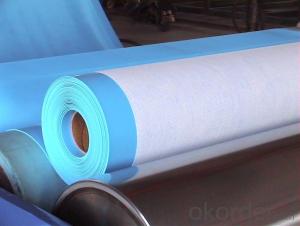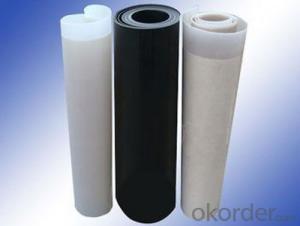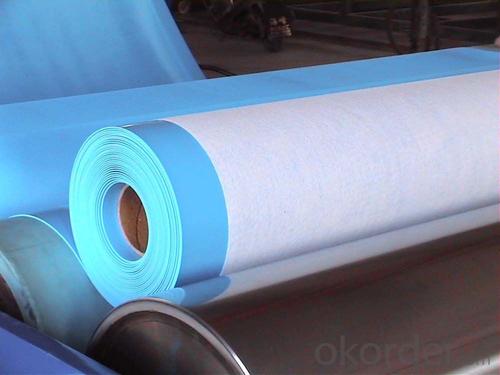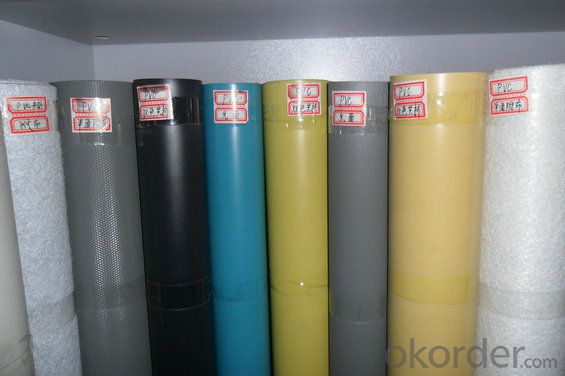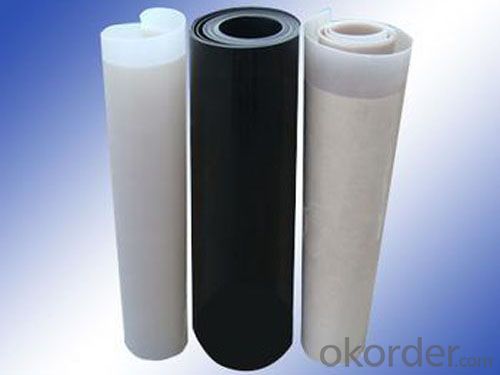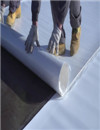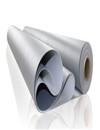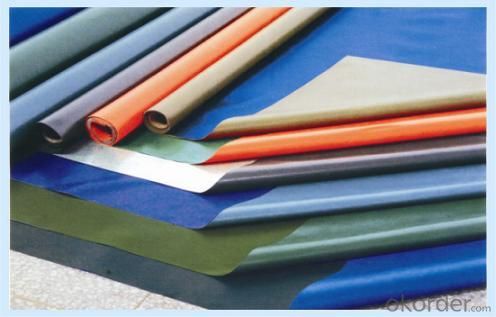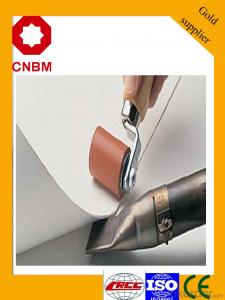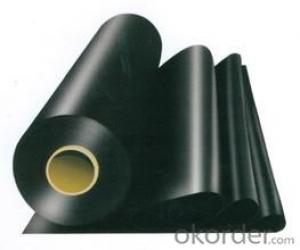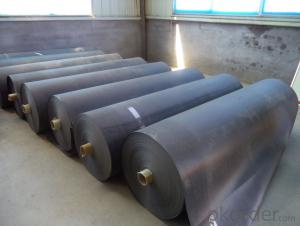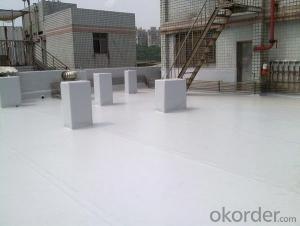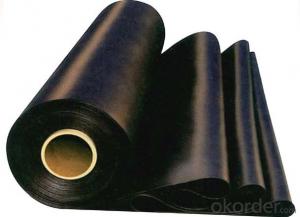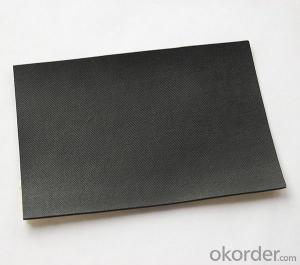Weldalbe EPDM rubber roofing waterproof membrane
- Loading Port:
- Qingdao
- Payment Terms:
- TT OR LC
- Min Order Qty:
- 20000 m²
- Supply Capability:
- 600000 m²/month
OKorder Service Pledge
OKorder Financial Service
You Might Also Like
Product Description of Weldalbe EPDM rubber roofing waterproof membrane:
EPDM waterproof membrane is of high elasticity among high polymer waterproof materials and becomes a world-popular waterproofing material. KEQIANG EPDM waterproof membrane is made from ternary ethylene-propylene rubber, which is designed for waterproofing of exposed and non-exposed applications. KEQIANG EPDM waterproof membrane production adopts the world-advanced equipment of cold feeding extrusion and continuous vulcanization technology.
Features of Weldalbe EPDM rubber roofing waterproof membrane:
·Excellent physical and mechanical performance
· High tearing resistance
· Good deformation adaptability
·High puncture resistance
·High aging resistance
·High UV resistance
Application of Weldalbe EPDM rubber roofing waterproof membrane:
l Roofs, Basement, Toilet
l Industrial and civil building waterproofing
l Geosynthetic liner for swimming pool, channels, irrigation system
l Especially suit for projects with high requirements in durability, anti-corrosion and deformation
Specification of Weldalbe EPDM rubber roofing waterproof membrane:
Tensile Strength N/CM | Normal temperature: 60 ; 60°C: 30 |
Breaking Elongation % | Normal temperature: 400 ; -20°C: 10 |
Tear Resistance N | 20 |
Impermeability, 30 min no leakage | 0.3Mpa |
Low Temperature Bending °C | -20 |
Heating Shrinking mm | Extension: 2 Shrink: 4 |
Heat Resistance (80°C×168h) | Tensile Strength % : 80 ; Keeping rate of adhesive breaking:70 |
Alkali resistance (10% ca (oh)2 solution,normal temperature ×168h)) | Tensile Strength % : 80 ; Keeping rate of adhesive breaking:80 |
Synthetic aging | Tensile Strength % : 80 ; Keeping rate of adhesive breaking:80 |
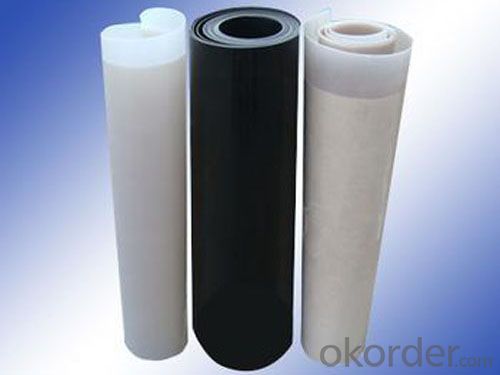
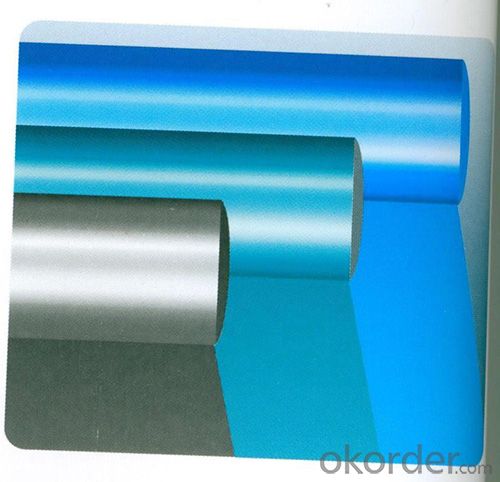
- Q: Can a waterproofing membrane be used in areas with vehicular traffic?
- Yes, a waterproofing membrane can be used in areas with vehicular traffic. In fact, there are specific types of waterproofing membranes designed to withstand the weight and movement of vehicles. These membranes, known as vehicular membranes or traffic-bearing membranes, are usually made of more durable materials such as rubberized asphalt or modified bitumen. They are designed to provide a strong and flexible barrier against water and moisture while also being able to handle the heavy loads and constant traffic associated with vehicles. Vehicular membranes are commonly used in parking garages, bridges, and other areas where vehicles are present.
- Q: What is the purpose of a waterproofing membrane?
- A waterproofing membrane serves the purpose of safeguarding buildings and structures against water infiltration and harm. Its design aims to establish a barrier that averts water from entering interior spaces or causing structural decay. Waterproofing membranes are commonly employed in areas like basements, roofs, walls, and foundations, where water intrusion is a prevalent concern. By sealing surfaces effectively and inhibiting moisture penetration, a waterproofing membrane aids in preserving the structure's integrity and lifespan. Additionally, it helps in preventing the growth of mold and mildew, both of which can be detrimental to the building and its occupants. In summary, the objective of a waterproofing membrane is to guarantee the durability, safety, and longevity of a structure by providing efficient protection against water damage.
- Q: Can a waterproofing membrane be used in cold climates?
- Indeed, a waterproofing membrane is suitable for use in cold climates. It is highly advisable to utilize a waterproofing membrane in cold climates to safeguard structures from moisture damage caused by snow, ice, and freezing temperatures. These membranes are engineered to possess flexibility and durability, enabling them to endure extreme temperature fluctuations without experiencing cracks or deterioration. They establish a barrier that thwarts water from permeating the structure, a critical factor in cold climates where water can freeze and expand, resulting in substantial harm to buildings and infrastructure. Additionally, certain waterproofing membranes are specifically formulated to excel in cold weather conditions, offering heightened resistance to freeze-thaw cycles and ensuring long-term protection against water infiltration. Therefore, it is imperative to employ a high-quality waterproofing membrane in cold climates to uphold the integrity and longevity of structures.
- Q: Can a waterproofing membrane be used for disaster relief structures?
- Indeed, disaster relief structures can benefit from the utilization of a waterproofing membrane. These membranes are specifically engineered to impede water infiltration and thus serve as an effective means of safeguarding temporary constructions in areas affected by calamities. Whether it be a transitory dwelling, medical establishment, or storage facility, a waterproofing membrane offers a formidable defense against precipitation, floods, and other water-related predicaments. By guaranteeing the dryness of the structure, it not only upholds the integrity of the relief edifice but also shields its inhabitants or stored provisions from water-induced harm. Moreover, waterproofing membranes are frequently lightweight, facile to install, and can be rapidly deployed during emergency scenarios, rendering them highly suitable for endeavors related to disaster relief.
- Q: Can a waterproofing membrane be used for crawl spaces or basements?
- Yes, a waterproofing membrane can be used for crawl spaces or basements. In fact, it is one of the most effective methods to prevent water infiltration and moisture issues in these areas. Waterproofing membranes are designed to create a protective barrier against water, preventing it from seeping into the crawl space or basement. They are typically made from durable materials such as rubber, PVC, or polyethylene, which are resistant to water penetration. These membranes are installed on the walls and floors of the crawl space or basement, creating a watertight seal. This helps to keep the area dry, prevent water damage, and reduce the risk of mold and mildew growth. Additionally, waterproofing membranes can also act as a vapor barrier, preventing moisture from evaporating from the ground and entering the crawl space or basement. Overall, using a waterproofing membrane is a recommended solution for maintaining a dry and healthy crawl space or basement.
- Q: Can a waterproofing membrane be used on tunnels with fire protection systems?
- Tunnels equipped with fire protection systems can indeed make use of a waterproofing membrane. It is actually quite common to recommend the use of a waterproofing membrane alongside fire protection systems in tunnels, as it adds an extra layer of safeguarding. The purpose of this membrane is to prevent any water from infiltrating the tunnel, as this could potentially harm the fire protection systems and undermine their effectiveness. By ensuring the tunnel remains watertight, the waterproofing membrane preserves the integrity and functionality of the fire protection systems, enabling them to fulfill their intended purpose in the event of a fire. Moreover, the waterproofing membrane can also serve as a barrier, impeding the spread of fire by blocking the passage of flames and smoke. Nonetheless, it is crucial to ensure that the chosen waterproofing membrane is compatible with the specific fire protection systems employed in the tunnel in order to ensure optimum performance and safety.
- Q: Can a waterproofing membrane be used on galvanized surfaces?
- Yes, a waterproofing membrane can be used on galvanized surfaces. The membrane provides an additional layer of protection against water penetration, which is especially important for galvanized surfaces that may be prone to rusting or corrosion.
- Q: Can a waterproofing membrane be used in conjunction with other waterproofing methods?
- Yes, a waterproofing membrane can be used in conjunction with other waterproofing methods. In fact, it is quite common to combine multiple waterproofing techniques to provide enhanced protection against water intrusion. Waterproofing membranes are often used as a primary waterproofing layer, providing a barrier against water penetration. However, they can be further reinforced by using other methods such as sealants, coatings, or drainage systems. These additional methods can help to address specific vulnerabilities, such as cracks, joints, or areas prone to high water pressure. By combining different waterproofing techniques, it is possible to create a comprehensive and effective waterproofing system that offers maximum protection against water damage.
- Q: Can a waterproofing membrane be used on tunnels with water drainage systems?
- Yes, a waterproofing membrane can be used on tunnels with water drainage systems. A waterproofing membrane is designed to provide a protective barrier against water penetration and can effectively prevent water leakage into the tunnel. However, it is important to ensure that the waterproofing membrane is compatible with the specific water drainage system in place. The membrane should be installed in such a way that it does not obstruct or interfere with the functioning of the drainage system. Additionally, proper consideration should be given to the design and installation of the drainage system to ensure efficient water management and prevent any potential issues that could compromise the effectiveness of the waterproofing membrane. Overall, with proper planning and installation, a waterproofing membrane can be successfully used in tunnels with water drainage systems to ensure the overall integrity and longevity of the structure.
- Q: Can a waterproofing membrane be used for elevator pits?
- Yes, a waterproofing membrane can be used for elevator pits. Elevator pits are typically located at the lowest level of a building and are prone to water infiltration, especially in areas with high groundwater levels or heavy rain. Installing a waterproofing membrane in the elevator pit can help prevent water from seeping in and causing damage to the elevator machinery or compromising the structural integrity of the pit. Waterproofing membranes are designed to create a barrier against water penetration and can be applied to the walls and floor of the elevator pit to ensure maximum protection. It is important to choose a high-quality waterproofing membrane that is specifically designed for below-grade applications and is capable of withstanding the constant exposure to moisture. Additionally, proper installation by trained professionals is crucial to ensure the effectiveness and durability of the waterproofing system.
Send your message to us
Weldalbe EPDM rubber roofing waterproof membrane
- Loading Port:
- Qingdao
- Payment Terms:
- TT OR LC
- Min Order Qty:
- 20000 m²
- Supply Capability:
- 600000 m²/month
OKorder Service Pledge
OKorder Financial Service
Similar products
Hot products
Hot Searches
Related keywords
